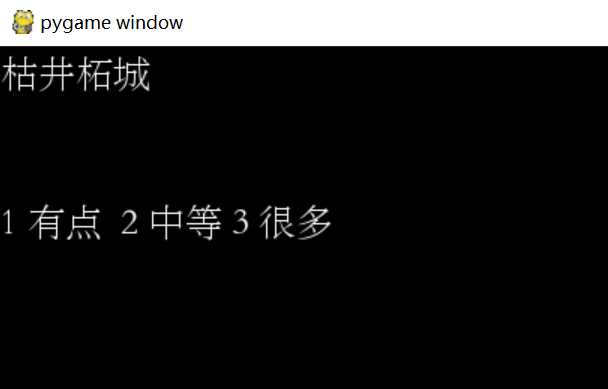标签:win val image == span mode wait print 优势
import pygame import sys from pygame.locals import * # wait for keys to putdown def waitForKeys(keysAllowed): key = False # initialize the key pygame.event.clear() # clear the event while not key: for i in pygame.event.get(): # for every event in the event list if i.type == pygame.KEYDOWN or i.type == pygame.KEYUP: # if the event type is keydown if i.key in keysAllowed : # if key is the special key # 如果是 if i.key == K_0 or K_1 or K_2 ,那么按任意一个键都将退出,因为 or 的逻辑成了(if i.key == K_0) or K_1 这种形式 print(i.key, pygame.key.name(i.key)) key = True # break the while loop return 0 # reture the value # draw a two sentences def displayOneQuestion(myString): pygame.init() # initialize pygame mywin = pygame.display.set_mode((800,600), DOUBLEBUF|HWSURFACE) # create the window myFont = pygame.font.SysFont("华文宋体", 25,False, False) # create the font myStringSurface = myFont.render(myString, True, (255,255,255), False) # create the string myString1 = "1 有点 2 中等 3 很多" myStringSurface1 = myFont.render(myString1, True, (255,255,255), None) mywin.blit(myStringSurface, (1,1), None, 0) # draw the font surface to another surface mywin.blit(myStringSurface1, (1,100), None, 0) # draw another surface pygame.display.flip() # flip the window return 0 # return 0 myString = ["你好啊","我不好","吃了吗","枯井柘城","没有呢","那好吧"] keysAllowed = [pygame.K_1, pygame.K_2, pygame.K_3, pygame.K_4, pygame.K_5] for element in myString: displayOneQuestion(element) waitForKeys(keysAllowed) # 注意点1 : 如果 pygame.event.clear() # clear the event 这一句放在 while :的开头,那么程序会非常慢,而且有的还会跳过,不知为什么。 # 注意点2: 如果是 if i.key == K_0 or K_1 or K_2 ,那么按任意一个键都将退出,因为 or 的逻辑成了(if i.key == K_0) or K_1 这种形式 ,而且if i.key == (K_0 or K_1)也是不行的。
这是一张问卷的问题的界面(当然问题是我瞎编的,并且也不是很美观,后期可以调整)
需要被试按键才能看下一题,按的键包括1,2,3,4,5

这是第二个问题的界面

这是完成5道题后的结果,我打印出了按键的ASC值,以及键的名称,可以看出名称为键盘上的数字按键。
总结:界面上的问题,问题的位置,答案的内容,答案的位置都可以设置,由于现在没有拿到问卷的内容,所以问卷内容是瞎写的。用pygame的主要优势是跳过了纸笔测验,而且可以将被试的反应(按键)存入数据库。
标签:win val image == span mode wait print 优势
原文地址:https://www.cnblogs.com/zijidefengge/p/12078901.html